Contents
Not long ago, we noticed an interesting trend: even businesses that had nothing to do with the usual tech sector were seeking UX studio's help to improve their websites and apps. Even big B2B players (Business-to-Business) were interested in UX research. As we delved into these industries, we realized that our usual research approaches for regular B2C (Business-to-Customers) companies weren't really cutting it. We began to identify some common patterns that needed special attention. We had to think differently when doing research with B2B customers.
Now, in this article, we’re sharing with you the tips we collected during years of hard work. Think of it as your compass for navigating the world of B2B research. Whether you’re a fellow UX researcher, a creative UX designer, or a product person, we’ve got your back.
By keeping these tips in mind, you’ll be ahead of the game when cooking up your next research plan. So, let’s dive in.
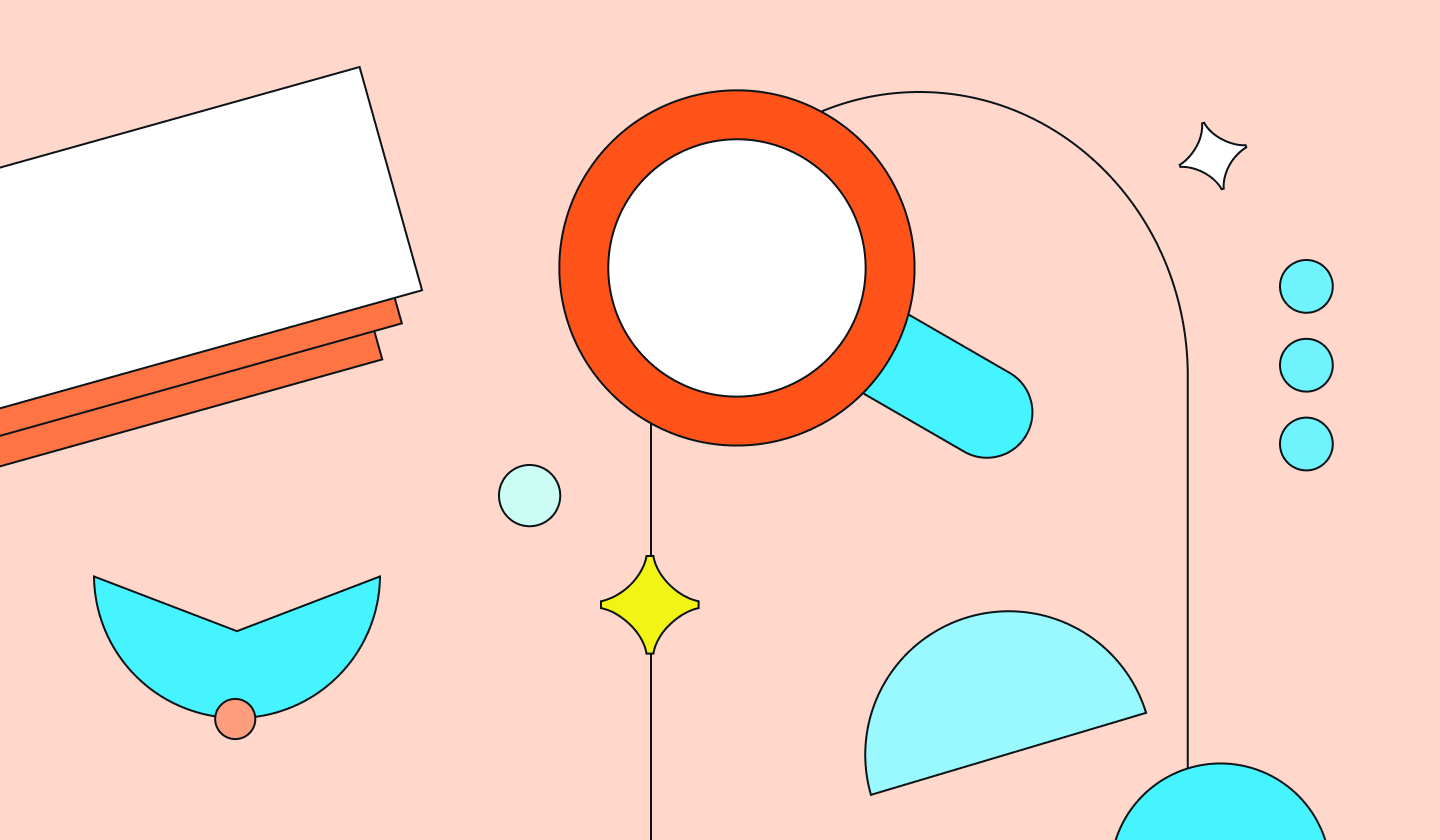
Who are the users in B2B
By definition, we talk about B2B when we see a transaction between two businesses. So, while the clients who pay for your work as a designer are in both sectors, we are talking about two different types of end users here: regular customers (B2C) and customers in business environments (B2B).
Naturally, it is crucial to recognize that B2B is, in itself, a broad domain. The users of a CRM platform differ from those on a B2B e-commerce platform. You will always need proper user research to dig deep into the intricacies of each sub-sector. Still, we have experienced some things about the users, which, when kept in mind, result in less hassle and better outcomes for your research projects.
✦ The value of a digital product
Imagine shopping online or searching for a note-taking app in Google Play. Do you do extended research before deciding on what to download? Do you have to make sure your return on your investment will be beneficial for you and your family or friends? Probably not.
When it comes to average purchases on a B2C platform, individual decisions are usually impulsive and driven by momentary preferences, emotions, and desires. However, in B2B sectors, it is different. These users have specific business objectives to achieve. Engaging in a user flow is often guided by necessity and not by delight. They also have to make sure the solution they buy is the best one long-term, even if it is not the most attractive one at the moment.
When coming from B2C research, you may be surprised that in B2B, the person who purchases the product is often entirely different from your end user. Or that it is not one single person who decides to use a digital service. But a couple of them. They are not focused on the best possible UI as they will not use it because it gives them delight. Instead, they commit to it because it facilitates seamless job performance.
Understanding this, you have to start your research by redefining your research questions. Focus on exploring how you can help your B2B users achieve their goals faster and smoother. And how you might show them what they win using this solution.
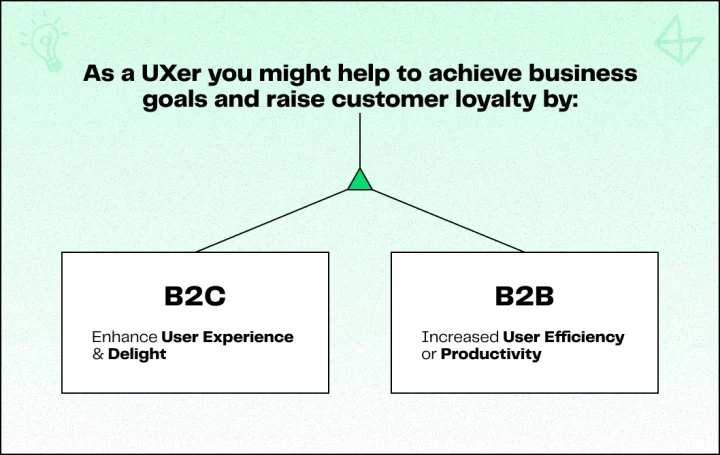
✦ Seeing things from their side
“The best products are born from a deep empathy with the people who use them.” Have you ever heard this saying from Bill Buxton? Well, we find it incredibly true. But when we worked on B2B products, we realized there was a bigger gap between users and the product teams. It makes sense.
We all shop online, so when designing “usual” B2C e-commerce solutions, it is not that hard to take our users’ perspective. But not many of us deal with complicated legal software or ship dangerous materials worldwide. These were B2B companies we worked with recently. We have observed that their needs can be a bit harder to grasp. Maybe that is why, in many B2B product teams, people only have a superficial understanding of their customers and their pain points. When they design for them, they still think with their own perspective, often viewing the interactions from a B2C point of view.
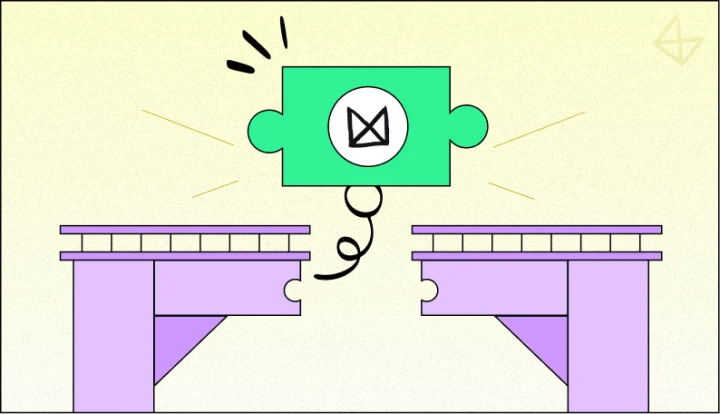
One example that comes to our mind is a client who had a B2B e-commerce platform that seemed unnecessarily complicated to the product team. The team had e-commerce experts who were great at their job and wanted to simplify the platform. But guess what we realized after running stakeholder interviews and mapping dependencies? Steps we initially thought were unimportant were actually crucial to achieving parity with national and international laws and legislation.
When thinking about B2B research, you have to be prepared to work hard to achieve empathy. You have to immerse yourself and the team into their reality and make sure that everyone is aware of the maybe less sexy rules and regulation parts of the B2B world.
✦ Relationship towards the product
Go to your phone and open up the list of applications you have. Do you know why you picked that particular fitness tracker? How much did you compare photo editors before downloading the one on your phone? If you’re like most B2C users, you probably made limited comparisons between products and decided to use them ad hoc. But B2B users are different. Product purchasers in this sector often conduct deep comparisons between certain products. Their decision is rooted in rationality, effectiveness, and optimal usage. They focus on achieving ROI.
Corresponding to that, we often see in B2B environment that relationships towards products are more stable and long-term than in B2C. While there is a large pool of users in B2C, they often only buy once or twice. There is usually a more considerable percentage of returning users in the case of B2B apps. In general, their relationship towards the digital products they use is more long-term.
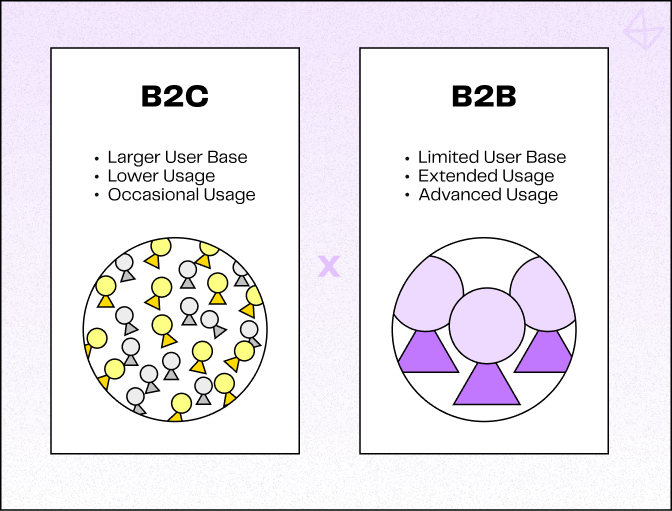
With returning users comes a bigger percentage of expert users here. They are usually more senior contributors in their field and use the given B2B product frequently. In the next part of our article, we will share our tips on how to prepare for researching this group.
Researching B2B users
Now that we have a grasp on how B2C and B2B users differ let’s tackle the big question: How does this change how we do our research? We’ve got some savvy tips up our sleeves straight from the playbook of the UX Studio research squads.
✦ Domain expertise
Don Norman attributes the success of UX professionals to being a generalist. However true, when it comes to B2B, a little insider knowledge goes a long way. Why do we emphasize this? Because contrary to B2C, as we have mentioned before, the B2B world is often not that easy to understand.
So what do we recommend? Do stakeholder interviews before actually starting your research project. Focus on collecting industry terms, processes, key players, and critical tasks. If you do B2B e-commerce, dive into how procurement generally works. If you design an application for chemists, do a LinkedIn deep dive to collect the usual job responsibilities. That way, your questions won’t sound like basic ABCs, but you can ask more informed questions. Trust us, a little homework goes a long way.
✦ Recruitment through external sources
The biggest challenge of B2B research is, by far, reaching the actional users. It is unlike B2C, where you just go to one of the hundreds of online panels. We know that there are online panels that do B2B recruitment. But, be aware the usefulness of these panels depends on the specific B2B industry. For example, when we had to find legal professionals from the States, Hotjar Engage and User Interviews were an easy and fast way to reach out to them. But when we needed to reach chemists for a supplier platform designed to order chemicals, suddenly the panel was not that big anymore.
- Do your homework
Here comes our first tip. Before you plan your research relying entirely on a panel that promises you access to B2B participants, ask them how much coverage they have in your current industry. Is it 200 participants? Or4000? And, if you run out of this pool, will they recruit additional participants? It is important to be aware that recruiting B2B participants often incurs additional fees beyond the standard B2C costs. That is why you shouldn’t shy away from these questions and make sure you get good service for your money.
. - LinkedIn: The good, the bad, and the meh.
B2B workers are already on LinkedIn, so why not use it to recruit from, right? Well, our answer is: strong ‘maybe.’ This is due to price, time, and response rate. Regarding the price, it is quite steep. The entry subscription for recruiting costs around 130 USD for a limited number of messages. But the bigger issue is time and response rate. Searching and filtering suitable research participant candidates one by one is time-consuming. And even after you find them, theresponse rate to an average message is quite low. So, we recommend using LinkedIn as your last resort for recruiting.
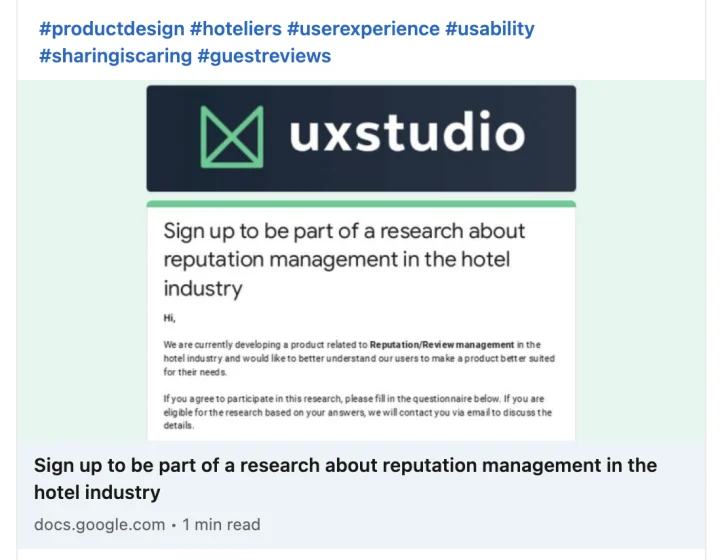 On the other hand, we have successfully experimented with posting sign-ups to research calls and asking our network to share them. This costs nothing and works exceptionally well when recruiting office workers.
On the other hand, we have successfully experimented with posting sign-ups to research calls and asking our network to share them. This costs nothing and works exceptionally well when recruiting office workers.
To sum up, although you can still rely on external panels, their pool is generally smaller for B2B compared to B2C users. Although LinkedIn often comes to B2B researchers’ mind, it may not be the best option in terms of effort/return rate. Don’t use these automatically, but always do a bit of groundwork and research before committing to them. This will save you time later on.
✦ Role of user panels
The most effective way to engage with B2B customers is by building a constant cohort of users – the user panel. Sure, there are many B2C companies, too, who are using an internal panel, but for researchers working in a B2B environment, it is like a secret weapon. Starting a user panel from scratch can be daunting, and your stakeholders will likely have questions. They want to ensure that this panel will not disrupt their relationship with the customers. We have collected some practices that, for us and our clients, have worked well.
- Find an owner for the panel
First thing first, you have to appoint somebody to be in charge of building and managing the panel. Most B2B companies have Customer Success Teams in constant contact with the customers (your company may call them by a different name, but look for the team responsible for onboarding clients and reacting to their problems). Team up with them. In our experience, they are the best ones to find the perfect panel members. Of course, make sure that they select participants in an unbiased manner. Or you are aware of what the bias is. A bias can be, for example, an expert user, a vocal user, or a complaining user.
. - Be creative with incentives
In many B2B sectors, incentives are not allowed. It would be considered a bribe if a company would pay certain positions from their customers. In these cases, you have to get creative to motivate your participants. We had success with offering free training for new products, the opportunity to access features in beta testing mode, and, generally, to allow them to shape the future of a program that they must use daily. Be confident in offering these incentives as they can be just as valuable as an Amazon gift card.
. - Manage expectations
If you research average B2C users, for example, about shopping habits on Facebook, they do not expect to get feedback on how their comments were implemented. They understand that their feedback is just one out of a huge user pool. But when working with an internal B2B user panel, users expect their feedback to make a difference. For example, if you do a lot of usability testing with them, but their feedback is not incorporated into the version they are working with, they can get demotivated. So, you must reassure them that the team is working hard to include their comments. Besides that, you also have to set expectations that the user panel is not a request line.
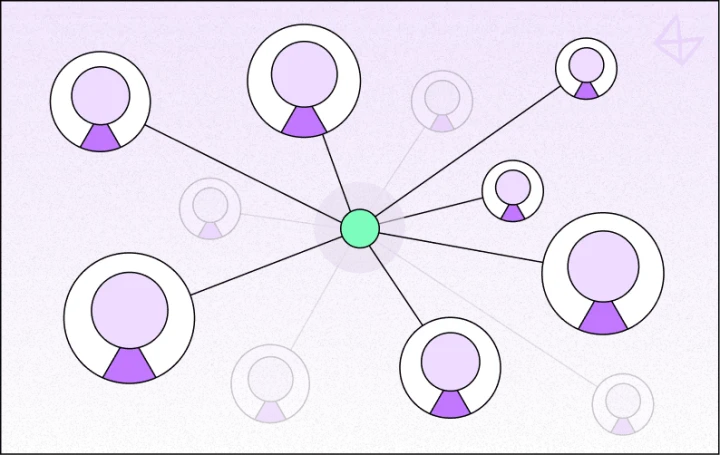
B2B users expect their feedback to make a difference - Record who you talk to
To avoid overusing the panel, administrate who you speak to. The same people should not be contacted too often. It is best to create clear guidelines for all panel managers and differentiate between invitation and participation and the type of research. For example, “we invite our users to surveys every three months” or “we might contact them for an interview every three months BUT they can be interviewed only every six months.”
It is also important to note the topic of the research that they were contacted about so you don’t ask the same questions again and again from the same participants.
To summarize, here is the golden rule: in B2B, user panels are much more recommended than any other type of recruitment source. They help you to get a steady flow of users during every product development phase. But, you have to set up clear responsibilities and rules so that participants don’t get frustrated. Especially if your company, like many in the B2B sector, is new to continuous research practices.
Our secret sauce
Time is more important than money. We found this painfully accurate in the B2B sector. In our experience, B2B participants are much harder to engage for extended sessions than B2C ones. To tackle this, we typically keep our interviews/usability tests to half an hour in this sector. Our motto is: having a short test is better than no test. Alternatively, we try to bundle different topics together – if two teams need to research two topics, we researchers often align and test them in the same session, so we stay within our small(er) pool.
A research method, often helpful in business environments, is the field study. As you observe the participants doing their job, you can close the gap between you and your B2B customer. This is especially useful with senior participants who are experienced in their work and accustomed to the imperfections of their current solutions. They might not mention any problems or pain points even when there are obvious flaws because they have already learned to work with flawed systems. By observing them, you can identify opportunities for them to save time and be more effective. This can give tremendous added value to your products.
Field studies also help map the workflows and understand the usage environment. Are the users bound to a desktop? Do they have to use specific internal systems to which your product has to correspond? If yes, in what way? That’s why we recommend being fearless in visiting B2B customers in their environment.
Summary
Alright, let’s sum up the most crucial learning points of years of working with B2B clients.
- Be aware that building empathy toward B2B users requires more effort than for B2C users. Walk a mile in their shoes by using field studies to emerge yourself in their environments and, after that, map their realities.
- Focus on how you can make the product usage more effective. Help your product team understand the differences between B2C and B2B user needs.
- Prepare yourself for recruitment challenges. Map your options carefully, be bold, and suggest building an internal user panel. If you do that, make sure that you do it in a respectful, organized way, working together with other customer-facing departments. Play a harmonious jam so the customer relationship stays strong.
Need more B2B research expertise?
We hope you could find some valuable bits of information from our B2B escapades. Need more help with B2B research? Contact our team so they can connect you to one of our experienced researchers.
Editors’ note: Special thanks to Lilla Schmidt for her exceptional blog post writing contributions to our company.




